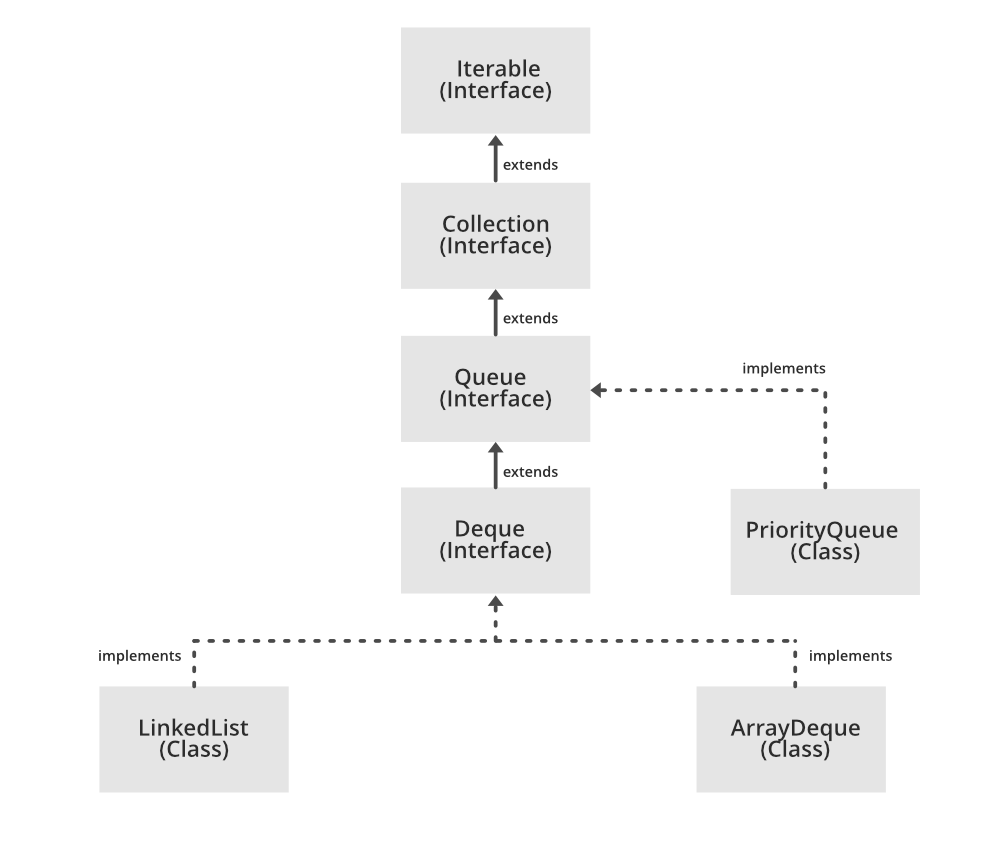Java程序 实现PriorityQueue API
PriorityQueue是一个线性数据结构,其中的元素根据其自然排序或在构造时在队列中提供的一些自定义比较器来排序。在PriorityQueue中,队列的前部指向最小的元素,而后部则根据自然排序指向最大的元素。对于按字母顺序排列的PriorityQueue,它们的ASCII值将被考虑用于排序。
PriorityQueue的一些重要特征如下。
- 它不允许插入空元素。
- 它是一个无界的队列,意味着它的大小可以扩展。
- 它继承了Object, Abstract Collection, AbstractQueue等类。
- 它不是线程安全的。
- 它不能为不可比较的对象创建。
各种操作的时间复杂性。
- 插入和删除是F阶O(log(n))。
- remove()和contains()方法的阶数是O(n)
- 检索操作是最快的,其顺序为O(1)。
PriorityQueue类继承了Queue接口和它的所有方法。PriorityQueue API实现了可序列化(serializable)、可迭代(Iterable)、集合(Collection)和队列(Queue),这可以从下图所示的架构中感知到。
Serializable, Iterable<E>, Collection<E>, Queue<E>

语法:
public class PriorityQueue<E> extends AbstractQueue<E> implements Serializable
参数: E – 这个队列中持有的元素的类型。
方法:
| 方法 | 类型 | 描述 |
|---|---|---|
| add(E e) | boolean | 在优先级队列中插入一个元素e |
| clear() | void | 移除PriorityQueue中的所有元素 |
| contains(Object O) | boolean | 如果它包含指定的元素,则返回true |
| iterator() | Iterator |
返回一个所有元素的迭代器 |
| remove(Object o) | boolean | 从队列中删除指定的元素 |
| comparator() | Comparator |
返回用于排序th元素的自定义比较器 |
| toArray() | Object[] | 返回一个包含PriorityQueue中所有元素的数组。 |
| peek() | 返回PriorityQueue的头部,而不从Queue中删除该元素。 | |
| poll() | 移除并返回队列的头部。如果队列是空的,则返回null。 | |
| spliterator() | Spliterator |
在PriorityQueue中的元素上创建一个晚期绑定的、故障快速的Spliterator。 |
Implementation:
示例
// Java Program to implement Priority Queue API
// Importing all classes from java.util package
import java.util.*;
// Class
class GFG {
// Main driver method
public static void main(String[] args)
{
// Creating(Declaring) an object of PriorityQueue of
// Integer type i.e Integer elements will be
// inserted in above object
PriorityQueue<Integer> pq = new PriorityQueue<>();
// Adding elements to the object created above
// Custom inputs
pq.add(89);
pq.add(67);
pq.add(78);
pq.add(12);
pq.add(19);
// Printing the head of the PriorityQueue
// using peek() method of Queues
System.out.println("PriorityQueue Head:"
+ pq.peek());
// Display message
System.out.println("\nPriorityQueue contents:");
// Defining the iterator to traverse over elements of
// object
Iterator i = pq.iterator();
// Condition check using hasNext() method which hold
// true till single element is remaining in List
while (i.hasNext()) {
// Printing the elements of object
System.out.print(i.next() + " ");
}
// Removing random element from above elements added
// from the PriorityQueue
// Custom removal be element equals 12
pq.remove(12);
// Display message
System.out.print("\nPriorityQueue contents:");
// Declaring iterator to traverse over object
// elements
Iterator it = pq.iterator();
// Condition check using hasNext() method which hold
// true till single element is remaining in List
while (it.hasNext()) {
// Printing the elements
System.out.print(it.next() + " ");
}
// Removing all the elements from the PriorityQueue
// using clear() method
pq.clear();
// Adding another different set of elements
// to the Queue object
// Custom different inputs
pq.add(5);
pq.add(7);
pq.add(2);
pq.add(9);
// Checking a random element just inserted
// using contains() which returns boolean value
System.out.print("The queue has 7 = "
+ pq.contains(7));
// Display message for content in Priority queue
System.out.print("\nPriorityQueue contents:");
// Converting PriorityQueue to array
// using toArray() method
Object[] arr = pq.toArray();
// Iterating over the array elements
for (int j = 0; j < arr.length; j++) {
// Printing all the elements in the array
System.out.print(arr[j] + " ");
}
}
}
输出
PriorityQueue Head:12
PriorityQueue contents:
12 19 78 89 67
PriorityQueue contents:19 67 78 89 The queue has 7 = true
PriorityQueue contents:2 7 5 9
 极客教程
极客教程